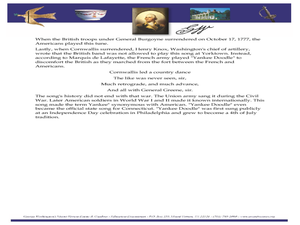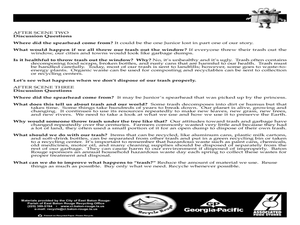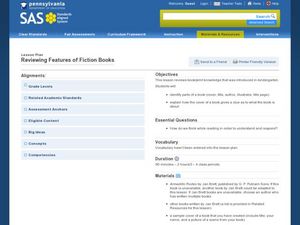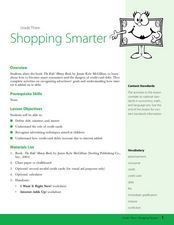Curated OER
George Washington in Song
Students establish similarities to George Washington's time in office with the song "Yankee Doodle." In this U.S. History activity, students learn the song "Yankee Doodle" then create a timeline of the song and a timeline of George...
Curated OER
Natural Disasters: An Adventure in Non-Fiction
Students study different natural disasters. In this natural disaster lesson students read a nonfiction book followed by a discussion, an experiment, then collect illustrations from their experience.
Curated OER
Health Education: Stress
Fourth graders tackle stress. In this personal health lesson plan, 4th graders predict physical and emotional reactions to stressful situations.
Curated OER
Poetry and Our National Anthem
Middle schoolers express the meaning of the Star-Spangled Banner. In this American history lesson, students read through the national anthem and complete an activities from a list of choices. Some choices include: writing the anthem in...
Curated OER
Chinese Minority Cultures
Seventh graders identify the elements that characterize culture in literature.
Students analyze the representation of Chinese minority peoples
through textbooks. Students identify and interpret the differences among the people of China.
Curated OER
An Eye on Science
Learners investigate the human eye and its parts. They read and discuss various books about eyes and sight, draw a rough draft of an eye diagram, and create a final draft of their eye diagram including labeled parts using Kid Pix...
Curated OER
Fitting Trash into Yesterday: A Fifth Grade Activity
Fifth graders explore the concept of waste management. In this recycling activity, 5th graders discover the history of waste management and discuss how the U.S. should respond to the issue of ever-increasing waste.
Curated OER
The Roots of Ahimsa
Students investigate the philosophy of nonviolence. In this Ghandi lesson, students discover that Gandhi inspired many civil rights leaders with the idea of ahimsa. Students complete venn diagrams, create timelines, and discuss...
Curated OER
Reviewing Features of Fiction Books
Young scholars identify the features of fiction books. In this genre study lesson, students are introduced to the book Armadillo Rodeo and identify the cover, title, author, illustrator and title page. Young scholars discuss how the book...
Curated OER
Aesop's Fables (Grade 3)
Third graders develop a presentation based on Aesop's Fables. In this Aesop Fables and presentation instructional activity, 3rd graders examine the characteristics of fables and how to interpret them. They choose one of Aesop's Fables to...
Curated OER
The Change of a River
Students explore changes in the Missouri River. For this Missouri River lesson, students discover that changes in the atmosphere cause changes in the river. Students search the Internet for information about the Missouri River and its...
Curated OER
Health Education: Germs
Fourth graders take part in a germ simulation activity. In this personal health lesson plan, 4th graders summarize methods for preventing the spread of germs that cause communicable diseases.
Curated OER
Into the Bat Cave
Students explore the lives of bats. In this bat lesson plan, students participate in up 6 activities that focus on bats and build their background knowledge about the nocturnal mammals.
Curated OER
Chameleons Are Cool!
Have your learners review what they know about camouflage using this lesson. Learners fill out a graphic organizer listing what they know or have questions about. This could be enhanced with the addition of a writing assignment in which...
Curated OER
Connection Stems
Pupils connect their lives to a story or nonfiction text. In this reading connections lesson, students make text-to-self, text-to-text, and text-to-world connections as they complete connections stems based on a story.
Curated OER
Shopping Smarter
Young scholars read a book about money and smart shopping to learn about debt, advertising, and the use of credit cards. In this consumer math lesson, students read the book The Kids' Money Book and discuss economic concepts. Young...
Curated OER
Saving Bambi
Eighth graders read two articles about what is being done with deer dangers. They react to the stories read. They are reacting to if deer should be shot or not to help cut down on the many dangers they impose.
Curated OER
Travels With Charley
Fifth graders engage in a literature study that uses a variety of texts in order to maximize their exposure to different reading situations. They examine each book in order to practice skills of reading comprehension. They recognize the...
Curated OER
Red Hot Resume
Students listen to a "Help Wanted" story, paraphrase the story, and discuss vocabulary. After reading the story again, students complete a worksheet replacing the vocabulary words with their own words so that the story makes sense to them.
Curated OER
Immigration to the United States
Middle schoolers discover the implications of immigration. For this immigration lesson, students read fiction based on immigration experiences as well as non-fiction on the topic. Middle schoolers write and share book reviews of the...
Curated OER
Parts of a Book
Second graders learn to identify the parts of a book. In this book parts lesson, 2nd graders learn the names of book parts by participating in a teacher led lesson in which they look at transparencies. They complete a worksheet in which...
Curated OER
Reef Attack
Students identify the locations of coral reefs. In this oceanography instructional activity, students use the Coral Reefs website to locate the coral reefs on a world map and discuss ways to help protect the coral reefs.
Curated OER
American Literature Unit Two
Students prepare for and respond to literature selections. This package includes nineteen lessons from the American Literature, A New Nation: 1750-1850 series, each covering a different reading selection. Pre-reading and response...
Curated OER
Slow and Steady Wins the Race
Students are introduced to the characteristics of fables. They read a fable by Aesop. In small groups, students identify fable characteristics present in Aesop's story and share their observations with the class.























